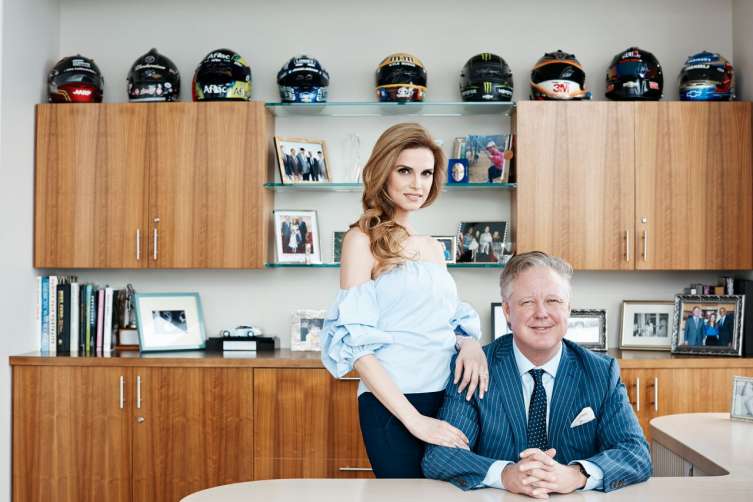Brian and Amy France Share Their Life in NYC as NASCAR’s First Family
Let’s start from the beginning. NASCAR’s roots stem as far back as World War II, a time when stock car racing experienced its first great spurt in popularity. While the sport was already gaining substantial traction, there was disparity in its organization. The year was 1947. The place was Daytona Beach, Florida. The man was Bill France Sr. It was “what real visionary entrepreneurs see, there was a market to be made,” says NASCAR’s current CEO, Brian France, about the man who started it all, his grandfather.
“He saw that stock car racing could be consolidated. There wasn’t any leadership or insurance, and nothing really came together to form a league. He had the vision to pull that together and convince everyone to go with him,” Brian continues. Approaching 70 years since its inception, NASCAR has seen tremendous growth and change. Brian France is now the third generation of France men to head the NASCAR corporation.
A lot has evolved since 1947, yet France has been able hold the lessons learned from his father and grandfather true to NASCAR. “In sport and business, everybody has to win. All of your stakeholders have to have the right seat at the table, and they all have to be successful. It’s hard to do, but you have to keep your eye on developing a meaningful relationship where it is beneficial for them. Then you work backwards from there,” Brian says. These lessons have helped turn NASCAR into the multibillion-dollar industry that it is today. Not only is it one of the most- watched sporting events on television, it also has some of the most loyal and committed fans.
These fans, old and new, are consuming NASCAR in entirely different ways than before. With the advent of social and digital media as an essential part of consumer outreach, NASCAR has had to adapt to capture that millennial attention. The company has been able to do so much more than simply grab attention; it has been able to further engage its massive audience. In 2015 alone NASCAR amassed 4.1 billion social media impressions and 1.1 billion page views, a 20 percent increase from 2014. This is on top of their 34 percent year-over-year increase in mobile audience.
Beyond numbers, NASCAR has also launched a few new partnerships in the social and digital realm. “We’re spending money in technology, and we’re very committed to using social and digital media to communicate with our fans new and old,” Brian comments. Among their new social investments is a partnership with Snapchat and extended partnership with Twitter.
NASCAR’s social success couldn’t be done without a little help from its friends. And by friends we mean celebrities like Vince Vaughn, Jonah Hill, Gerard Butler, David Spade and Adam Sandler. The celebrity pull to the stock car racing con- glomerate has involved an even broader audience. Not to mention the fact that nearly 230 million viewers watched NASCAR drivers appear in 77 primetime shows in 2015. While all of these names and numbers are beyond notable, what is truly impressive is the France’s capacity to manage it all.

Brian and his wife, Amy, have seemingly perfected the art of balancing their personal and professional lives. As the first family of NASCAR, the power couple has a lot on their plate. Yet with poise and elegance Amy describes how their days are “very normal in a sense. In many ways our story is very relatable. So much of our time is developed around me managing our home and family life and Brian managing his professional responsibilities. The two of us are great partners.” Even though Brian’s hectic NASCAR schedule demands a lot of time, Amy continues to explain how they “always try and sit down to have a couple minutes together as a family and start out the day.”
The incredibly in sync pair just celebrated a seventh wedding anniversary this January with their 5-year-old twins, Luke and Meadow. Amy France grew up in Northern California and prior to meeting her beau had never attended a NASCAR race. “When Brian and I met and our relationship developed, I began to appreciate how much NASCAR has grown outside of the Southeast from a marketing, licensing and sponsorship perspective. Slowly but surely NASCAR has a way of sneaking up on you. Lo and behold seven years of marriage later I am an avid NASCAR enthusiast, as well,” Amy expresses unreservedly. The superwoman not only upholds the France household, but she also acts as a great support for Brian in his professional endeavors, too.
“I use Amy as a major sounding board for a lot of things that come up, and she understands the family dynamic and business dynamics better than people would think. She is a big support and voice of calm when things are a little bit dicey like great wives can be. She does all of that,” Brian affirms.
When Amy isn’t supporting Brian in business, she is managing all things Luke and Meadow. “I walk my children to and from school every single day. When we have weather conditions we all carry our little umbrellas. We’re a really grounded, traditional family,” Amy explains. While you might imagine the glamorous home life of the CEO to a billion-dollar business to be unlike any others, Amy suggests that “what millions of families go through is sort of the typical France household storyline, as well. It’s lots of managing and balancing and working with the ebbs and flows.”
Even with all of their responsibilities and daily tasks, Brian and Amy always make sure they carve out some time for each other. “We slip away when we can; we do lots of date nights. We love Le Cirque, we like our quiet little neighborhood Italian spots up the street, as well. We like a grand night out and toned down nights, as well. It’s about the quality alone time. We think we do a good job,” Amy continues.
While making time for each other is an essential part of their marriage, the kids always come first. The beautiful boy and girl twins have already developed interests much beyond their years. Outside of parenting and education, they have also begun learning lessons from time spent at the racetrack. “We’ve seen that our children enjoy being at the racetrack, and we have been able to take this big joy and desire to be there to help parent. The amount of respect and understanding that our kids have that this is someone’s workplace, and they need to be quiet and mindful is unheard of for children their age. That has been one of the benefits about how Brian and I balance work and home life is the ability to merge it,” Amy says.
As a family-owned and centric business, having Luke and Meadow take interest in NASCAR is a testament to generations of tradition. However, much like in Brian’s upbringing, there is no mandate for what the France children should grow up to be. Brian describes how his parents “were really open-minded to whatever I wanted to do.” A philosophy he and Amy plan on passing on to their children, as well. As curious and thriving 5-year-olds, Brian’s only current concern is “trying to keep them in the management lane, not the driving lane,” he jokes. Amy continues to explain the pride and respect the children already have for NASCAR and what Brian does, especially their sports-enthused son, Luke.
“From observing my son’s passion and enthusiasm, one of the things that I have noticed is that when he gets to share that feeling of victory with that one driver who wins the race versus a team, it’s a personal identification,” Amy notes. We had to know the NASCAR heir’s favorite racer du jour. With no reservations Amy proclaims how “he is outspoken about his favorite driver. He loves Joey Logano and is very loyal to him.” Luke’s excitement and ability to resonate with a specific driver is one of the same reasons so many Americans have fallen in love with the sport.
NASCAR has become one of the most popular sports in the country. Fans from the East to West Coasts make it a point to gather together and support their favorite racers whenever they can. So why did stock car racing become so significant to so many people? “Everybody drives a car, start with that. There are a lot of characters in the sport, too. People like that authenticity; it is truly Americana, too,” Brian explains.
While many relate to NASCAR for the pure love of racing, a lot of fans admire the company because of its family history. There is no doubt that people connect with the idea of a family deeply rooted and invested in the success of the sport. “I think there is something endearing about knowing there is a family that figuratively and literally put their sweat and hard years of work to build it to what it is today,” Amy says. The Frances have been able to maintain the core of NASCAR, and although they hope their children will choose to uphold the same tradition, they plan on passing down something just as special.
If you haven’t done so already, you should take the time to involve yourself with the Luke & Meadow Foundation. Shortly after having their healthy twins, Brian and Amy decided to become a force behind ensuring that more children have the opportunity for health and security, as well. The foundation is aimed at providing underprivileged and neglected children the resources and opportunity to thrive in life. Spanning from medical attention to education, the Frances are doing whatever they can to give these children a chance at a prosperous future.

Photo Credit: Platon, Courtesy of the Metropolitan Museum of Art
“We decided to form a foundation that we could channel our philanthropic efforts through as the years go on. We decided to name it Luke & Meadow because I want this to be something our kids take on down the road as their own,” Amy explains. While the young twins may not fully understand the power and meaning behind the Luke & Meadow Foundation just yet, they are now beginning to gain awareness of its existence. “They have been at the track when we have hosted cancer survivors and their families. They understand that these are sick children, and it’s a special treat for them to be at the racetrack. That’s where they are starting to identify,” Amy says with pride. The Luke & Meadow Foundation is currently focusing efforts on cancer research and supporting local hospitals along with pediatric wings within them. 2016 is poised to be an impactful year for the foundation, and an even bigger year for NASCAR.
After the 2013 record-breaking television deal, the largest in NASCAR’s history worth an estimated $8.2 billion, the future for the industry was in good hands. The 10-year deal with FOX and NBC ensured that the sport would be delivered to its loyal audience for the next decade. With that in place, the future left room to build on new areas of NASCAR. “Things are pretty good for NASCAR with our TV agreements behind us and so forth. For us it’s focusing on putting the best events and tightest racing that we can, making improvements on the track and investing in the amenities and fan experience,” Brian elaborates.
The future of NASCAR and its fans are as committed as it was in 1947. Although a lot has changed since then, the relationship between racers and their audience forged by NASCAR continues to flourish. The industry continues to expand through digital developments, additional racetracks, international exposure and a continuously growing following. As the CEO says himself, “A lot is happening for us. It is most certainly a good outlook for NASCAR.”















